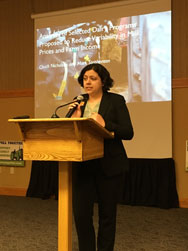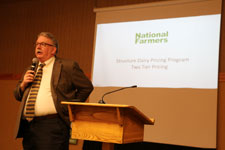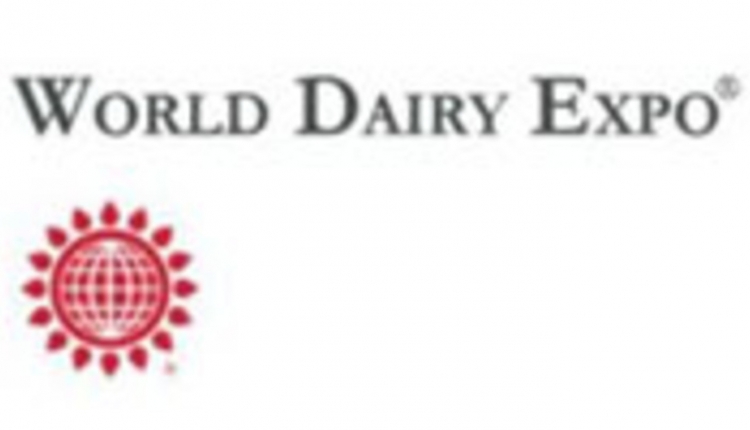

Hundreds of farmers have been gathering for Dairy Together Road Show events across Wisconsin this month. Organized by the National Farmers Organization (NFO) and Wisconsin Farmers Union (WFU), the events are engaging farmers on proposals to rebuild a viable dairy economy. Meetings have been held in Oshkosh and Eau Claire and another is planned tomorrow, April 4, in Platteville before the Road Show treks onward to Michigan, Minnesota, New Mexico and California. Farmers also gathered for Road Show stops in New York and Vermont.
“The plans we’re presenting today move the industry away from consolidation and help level the playing field so independent farmers have a fighting chance,” Wisconsin Farmers Union President Darin Von Ruden said to the crowd of 100 farmers gathered at an April 2 Dairy Together Road Show meeting in Eau Claire.
WFU and NFO are presenting several potential pathways forward for a national movement on dairy reform. Though the family farm organizations’ plans differ in some details, they are united in aiming to give the dairy industry more control over production. Addressing direly needed structural changes and reducing volatility are key goals, while the groups note that other oft-covered topics like exports, school lunches, dairy labeling and milk mustaches have been purposefully set to the side.
“Although export markets are important, we are certain that we cannot export our way out of this problem,” Von Ruden said. “We’ve heard over and over from dairy farmers that they don’t want to put their fate in the hands of global dairy markets that they cannot control.”
A need for structural change – and short-term relief
“We have what policy people call a structure problem,” said NFO’s Dick Levins, professor emeritus of ag economics at the University of Minnesota. “By that we don’t mean barns falling down, we mean the mix of farmers out there is changing so dramatically that pretty soon there won’t be room for the family farmer.”
Levins noted that between 2000 and 2017, the U.S. lost 63,702 dairy farms with herds of 200 cows or less, a decrease of 65.6 percent. Meanwhile, operations with over 1,000 cows increased by 109 percent and those with over 2,000 cows by 268 percent.
“As those family-sized dairies leave, the particular benefits they provide to rural economies, the environment, and food security go with them,” Levins said.
Recognizing the staggering rate at which the nation is losing family-sized farms, NFO is proposing The Family Dairy Farm Relief Act, a voluntary program that would base emergency relief payments on different tiers that recognize variations in operating costs for different size farms. Monthly payments would be set according to a farm’s level of production, with smaller farms receiving relatively higher payments per hundredweight. The plan is modeled off of the Maine Dairy Relief Program, which was implemented in 2004 and has effectively slowed the loss of dairy farms in the state.
Levins stressed that the program would not impact milk prices and is intended to be a short-term bridge until a more market-oriented, long term program – one not dependent on government payments – could be implemented. He added that the already existing model is one that could be easily and rapidly enacted by Congress.
Proposals for long-term solutions

While The Family Dairy Farm Relief Act could provide short-term relief, WFU Government Relations Associate Bobbi Wilson echoed the point that it would be only a lifeline until long-term solutions can be implemented.
“What we’re hearing from farmers is that they’d rather have a fair price from the market than a handout,” Wilson said.
A long-term plan proposed to curb overproduction, improve milk prices and provide long-term stability is the Dairy Price Stabilization Plan, which was originally proposed in the lead-up to the 2014 Farm Bill. Dairy economists Chuck Nicholson from Cornell University and Mark Stephenson from the University of Wisconsin recently unveiled research on the impact this program might have had in current market conditions.
“The bottom line on what we found was generally pretty positive in terms of thinking of what these programs could do,” Nicholson said. “We saw reduced variation in prices and also some price enhancement, increased net farm operating incomes, reduction in the rate of farm exits across farms of all sizes, and a reduction in government expenditures on dairy programs.”
Through the DPSP, farmers who choose to expand beyond an allowable growth rate (based on market demand) must pay a market access fee. That fee would then be distributed among all the farmers who chose not to expand. Two versions of the plan are currently on the table – one that would operate continuously and another that would be triggered when the milk:feed ratio drops below a certain level.
Under the plan, farms could choose to expand production and pay the market access fee (ranging from $0.015/cwt to $3/cwt) or limit their expansion and receive a market access fee disbursement (ranging from $1.50/cwt to $1.88/cwt).
Wilson noted this plan looks to better balance milk supply and demand and cause farms to reconsider expansions, an important effort considering milk production continues to climb despite continued farm loss and a glut of dairy on the market. The USDA recently forecasted 219.7 billion pounds of milk production for 2019, up more than 2 billion pounds over 2018.

The Road Show also offers up the Structured Dairy Pricing Program as a potential long-term solution to the dairy crisis. Research on the plan has been spearheaded by NFO Director of Dairy Sales Dick Bylsma, who also brings to the table a dairy farming upbringing and a strong background in milk bottling and cheese processing.
The Structured Dairy Pricing Program looks to curb production by establishing a national Federal Milk Marketing Order with a $4/cwt price adjuster for up to one million pounds of monthly production for every dairy farm in the country. The proposal would help reduce the cost of production difference between small and large farms in a way similar to FMMO procedures that account for different class prices.
“We have created a scenario where every dairy farmer has a positive margin,” Bylsma said. He also stressed that the Structured Dairy Pricing Program would not increase costs to consumers or impact the price a cheese processor or milk bottling company pays for their milk.
He reiterated the importance of addressing the continued loss and growing consolidation in the American dairy industry, citing an April 25, 2017 Hoard’s Dairyman article by Jack Britt that projects the U.S. could have as few as 1,300 to 1,900 dairy farms by the year 2066. That scenario is a direct contradiction to consumer preferences which trend toward a desire for family farms on the American landscape, Bylsma noted.
“We recognize that if we let these family farmers go out of business, we won’t get them back,” Bylsma added. “Our proposal makes rural communities stronger and helps keep this treasure we call the family farm in business.”
It’s going to take a movement
In closing, the groups recognized that any meaningful change in the dairy industry is going to require strong coalition building.
“We know that to get anything changed at the federal level, we’re going to need people power,” said WFU Special Projects Director Sarah Lloyd. “It’s very encouraging that we’re packing the rooms for these meetings – now we need to spread the word to our elected decision makers, implement our people power through our co-ops, and get everybody on board – processors, veterinarians, seed sales representatives. These proposals are strong enough to make a difference and move the industry away from consolidation.”
Find handouts, videos and more resources about the proposals, details on upcoming events, and a sign-up to keep informed at www.dairytogether.com.


